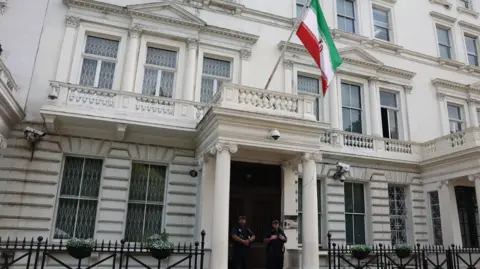In recent events, seven men have been charged with grievous bodily harm following a violent protest that took place outside the Iranian embassy located in Princes Gate, Knightsbridge, London. According to the Metropolitan Police, this incident occurred shortly after 09:50 BST on a Friday morning when officers responded to reports of a brawl that broke out during the demonstration.
The police promptly intervened, deploying additional officers to manage the situation and restore order. During the altercation, two men, aged 37 and 39, sustained serious injuries, although authorities clarified that their injuries were not life-threatening. They were subsequently taken to a nearby hospital for medical care.
The fallout from the protest saw eight individuals arrested in connection with the violent events. Among these arrests, specific attention was drawn to the aforementioned 39-year-old man, who was one of the injured and was also hospitalized. As investigations progressed, seven of those initially apprehended faced formal charges of grievous bodily harm. They were remanded into custody and are scheduled to appear at Westminster Magistrates’ Court on the following Monday.
The demographic of the charged individuals is notably diverse, with men coming from different regions across the UK, including major cities such as London, Liverpool, and Birmingham. This geographical variety underscores the national significance of the protest, which evokes wider political and social sentiments regarding Iranian policies and actions.
The eighth individual who was arrested remains hospitalized and has been released on bail, with the specifics of their condition and involvement in the altercation currently unclear. In light of the violence and the potential for further disturbances, authorities established conditions to deter any significant disorder at the Iranian embassy. These measures involve restricting protesters from gathering around the embassy premises until 13:00 BST on the following Sunday.
Such incidents highlight the rising tensions surrounding diplomatic missions and the continuous involvement of various groups in protests related to international affairs. The Iranian government is often a focal point for demonstrations, particularly concerning its policies and the human rights situation within Iran. The implications of protests on foreign soil resonate with delicate diplomatic relations, often influencing government responses in both the host country and the one represented.
As this situation unfolds, it raises questions about the nature of protests, the right to demonstrate peacefully, and the extent to which authorities should intervene to maintain order. The aftermath will likely be closely monitored not just by local law enforcement but also by advocates for civil liberties and international observers interested in human rights issues. Such occurrences serve as crucial indicators of the broader social atmosphere and can evoke varying reactions from the public, depending on their perspectives on the issues at stake.
In summary, the protest outside the Iranian embassy resulted in serious injuries and numerous arrests, raising significant concerns about public safety and civil rights. As the charged parties prepare for court, the broader implications of their actions will resonate throughout the diplomatic landscape, potentially influencing future protests and governmental policies surrounding international demonstrations.



